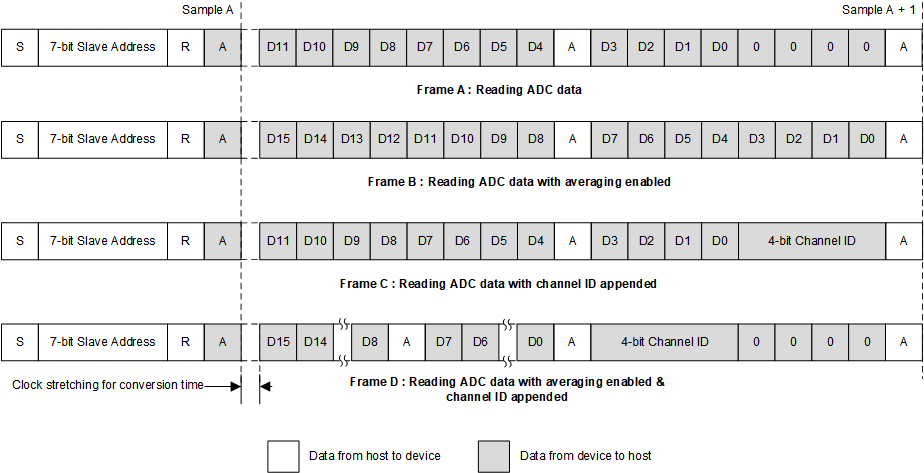SBAS961A May 2019 – April 2020 TLA2528
PRODUCTION DATA.
- 1 Features
- 2 Applications
- 3 Description
- 4 Revision History
- 5 Pin Configuration and Functions
- 6 Specifications
-
7 Detailed Description
- 7.1 Overview
- 7.2 Functional Block Diagram
- 7.3 Feature Description
- 7.4 Device Functional Modes
- 7.5 Programming
- 7.6
TLA2528 Registers
- 7.6.1 SYSTEM_STATUS Register (Address = 0x0) [reset = 0x80]
- 7.6.2 GENERAL_CFG Register (Address = 0x1) [reset = 0x0]
- 7.6.3 DATA_CFG Register (Address = 0x2) [reset = 0x0]
- 7.6.4 OSR_CFG Register (Address = 0x3) [reset = 0x0]
- 7.6.5 OPMODE_CFG Register (Address = 0x4) [reset = 0x0]
- 7.6.6 PIN_CFG Register (Address = 0x5) [reset = 0x0]
- 7.6.7 GPIO_CFG Register (Address = 0x7) [reset = 0x0]
- 7.6.8 GPO_DRIVE_CFG Register (Address = 0x9) [reset = 0x0]
- 7.6.9 GPO_VALUE Register (Address = 0xB) [reset = 0x0]
- 7.6.10 GPI_VALUE Register (Address = 0xD) [reset = 0x0]
- 7.6.11 SEQUENCE_CFG Register (Address = 0x10) [reset = 0x0]
- 7.6.12 CHANNEL_SEL Register (Address = 0x11) [reset = 0x0]
- 7.6.13 AUTO_SEQ_CH_SEL Register (Address = 0x12) [reset = 0x0]
- 8 Application and Implementation
- 9 Power Supply Recommendations
- 10Layout
- 11Device and Documentation Support
- 12Mechanical, Packaging, and Orderable Information
パッケージ・オプション
メカニカル・データ(パッケージ|ピン)
- RTE|16
サーマルパッド・メカニカル・データ
- RTE|16
発注情報
7.3.9 Output Data Format
Figure 25 illustrates various I2C frames for reading data.
- Read the ADC conversion result: Two 8-bit I2C packets are required (frame A).
- Read the averaged conversion result: Two 8-bit I2C packets are required (frame B).
- Read data with the channel ID appended: The 4-bit channel ID can be appended to the 12-bit ADC result by configuring the APPEND_STATUS field in the GENERAL_CFG register. When the channel ID is appended to the 12-bit ADC data, two I2C packets are required (frame C). If the channel ID is appended to the 16-bit average result, three I2C frames are required (frame D).
 Figure 25. Data Frames for Reading Data
Figure 25. Data Frames for Reading Data